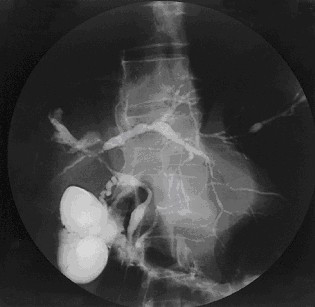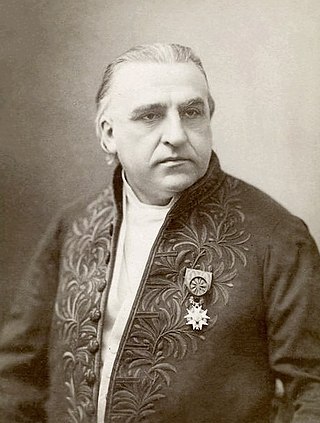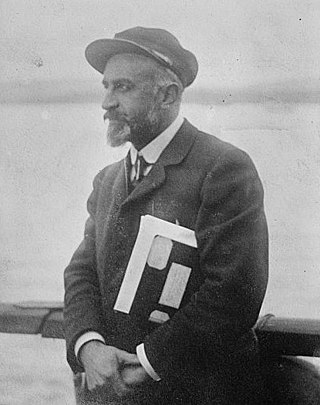
Tacticity is the relative stereochemistry of adjacent chiral centers within a macromolecule. The practical significance of tacticity rests on the effects on the physical properties of the polymer. The regularity of the macromolecular structure influences the degree to which it has rigid, crystalline long range order or flexible, amorphous long range disorder. Precise knowledge of tacticity of a polymer also helps understanding at what temperature a polymer melts, how soluble it is in a solvent and its mechanical properties.
Tetrad or tetrade may refer to:
Triad or triade may refer to:

Primary biliary cholangitis (PBC), previously known as primary biliary cirrhosis, is an autoimmune disease of the liver. It results from a slow, progressive destruction of the small bile ducts of the liver, causing bile and other toxins to build up in the liver, a condition called cholestasis. Further slow damage to the liver tissue can lead to scarring, fibrosis, and eventually cirrhosis.

Endoscopic retrograde cholangiopancreatography (ERCP) is a technique that combines the use of endoscopy and fluoroscopy to diagnose and treat certain problems of the biliary or pancreatic ductal systems. It is primarily performed by highly skilled and specialty trained gastroenterologists. Through the endoscope, the physician can see the inside of the stomach and duodenum, and inject a contrast medium into the ducts in the biliary tree and/or pancreas so they can be seen on radiographs.
Charcot's neurologic triad is the combination of nystagmus, intention tremor, and scanning or staccato speech. This triad is associated with multiple sclerosis, where it was first described; however, it is not considered pathognomonic for it. It is named after Jean-Martin Charcot.

Primary sclerosing cholangitis (PSC) is a long-term progressive disease of the liver and gallbladder characterized by inflammation and scarring of the bile ducts, which normally allow bile to drain from the gallbladder. Affected individuals may have no symptoms or may experience signs and symptoms of liver disease, such as yellow discoloration of the skin and eyes, itching, and abdominal pain.

Jean-Martin Charcot was a French neurologist and professor of anatomical pathology. He worked on groundbreaking work about hypnosis and hysteria, in particular with his hysteria patient Louise Augustine Gleizes. Charcot is known as "the founder of modern neurology", and his name has been associated with at least 15 medical eponyms, including various conditions sometimes referred to as Charcot diseases.
In medicine, Murphy's sign is a maneuver during a physical examination as part of the abdominal examination. It is useful for differentiating pain in the right upper quadrant. Typically, it is positive in cholecystitis, but negative in choledocholithiasis, pyelonephritis, and ascending cholangitis.

Jean-Baptiste Étienne Auguste Charcot, better known in France as Commandant Charcot, (15 July 1867 in Neuilly-sur-Seine near Paris – 16 September 1936 at sea, was a French scientist, medical doctor and polar scientist. His father was the neurologist Jean-Martin Charcot . As a sportsman, he was French rugby XV champion in 1896 and also won a double silver medal in sailing at the 1900 Summer Olympics.
Intention tremor is a dyskinetic disorder characterized by a broad, coarse, and low-frequency tremor evident during deliberate and visually-guided movement. An intention tremor is usually perpendicular to the direction of movement. When experiencing an intention tremor, one often overshoots or undershoots one's target, a condition known as dysmetria. Intention tremor is the result of dysfunction of the cerebellum, particularly on the same side as the tremor in the lateral zone, which controls visually guided movements. Depending on the location of cerebellar damage, these tremors can be either unilateral or bilateral.

Ascending cholangitis, also known as acute cholangitis or simply cholangitis, is inflammation of the bile duct, usually caused by bacteria ascending from its junction with the duodenum. It tends to occur if the bile duct is already partially obstructed by gallstones.
Reynolds' pentad is a collection of signs and symptoms consistent with obstructive ascending cholangitis, a serious infection of the biliary tract. It is a combination of Charcot's triad with shock and an altered mental status. Sometimes the two additional signs are listed simply as low blood pressure and confusion.

The biliary tract refers to the liver, gallbladder and bile ducts, and how they work together to make, store and secrete bile. Bile consists of water, electrolytes, bile acids, cholesterol, phospholipids and conjugated bilirubin. Some components are synthesized by hepatocytes ; the rest are extracted from the blood by the liver.
Ductopenia refers to a reduction in the number of ducts in an organ, in particular the absence of bile ducts of the expected size in the portal tract of the liver. It is the histological hallmark of vanishing bile duct syndrome. The most common cause of ductopenia is primary biliary cholangitis.
Scanning speech is a type of ataxic dysarthria in which spoken words are broken up into separate syllables, often separated by a noticeable pause, and spoken with varying force. The sentence "Walking is good exercise", for example, might be pronounced as "Walk (pause) ing is good ex (pause) er (pause) cise". Additionally, stress may be placed on unusual syllables.
The tone clock, and its related compositional theory tone-clock theory, is a post-tonal music composition technique, developed by composers Peter Schat and Jenny McLeod. The purpose of the tone-clock is to consistently order chromatic pitches into 12 triads where each pitch is used only once. Music written using tone-clock theory features a high economy of musical intervals within a generally chromatic musical language. This is because tone-clock theory encourages the composer to generate all their harmonic and melodic material from a limited number of intervallic configurations. Tone-clock theory is also concerned with the way that the three-note pitch-class sets can be shown to underlie larger sets, and considers these triads as a fundamental unit in the harmonic world of any piece. Because there are twelve possible triadic prime forms, Schat called them the "hours", and imagined them arrayed in a clock face, with the smallest hour in the one o'clock position, and the largest hour in the 12 o'clock position. A notable feature of tone-clock theory is tone-clock steering: transposing or inverting hours so that each note of the chromatic aggregate is generated once and once only.








